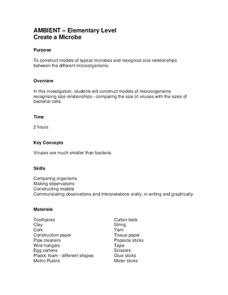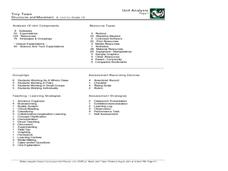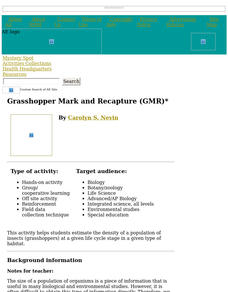Curated OER
Nobody Really Won
Young scholars watch a video on "Custer's Last Stand" written with the perspective of the soldier. They listen to the story of "Red Hawk's Last Account" to become aware of the Native American's perspective. In groups, students create...
Curated OER
Determining the Geologic History of Rocks from a Gravel Deposit
Students apply the scientific method to identify rocks from glacial deposits, hypothesize how they got there and then test their hypothesis. They are given the experience of active, hands-on inquiry.
Curated OER
Time Lapse Seed Germination with the QX3 Intel Digital Microscope
Students use the time-lapse feature of the QX3 Intel Digital Microscope
to observe germination of seeds. They use the QX3 Intel Digital microscope to create time lapse video films of seed germination experiments.
Curated OER
Get to Know Your City
Third graders research the history of their home city and how it's development was influenced by different groups of people. They present their research information to the class.
Curated OER
Flowers: Form and Function
Students recognize and name the parts of a flower. They explain the function of each part of a flower. Students list the steps that occur for sexual reproduction of a plant to take place. They recognize and name the male reproductive...
Curated OER
Create a microbe
Young scholars explore viruses and bacteria. They construct three dimensional models of microorganisms recognizing size relationships by comparing the size of viruses with the sizes of bacterial cells.
Curated OER
Elements for Disaster Reporting
Students identify the elements of natural disasters and gain an understanding on how the media influences people's responses to disasters. In this natural disaster lesson plan, students study the impact of natural disasters, and the...
Curated OER
School of Fish
Student explore the natural resources of Buffalo National River. In this natural resources activity ,students discuss the fish and other animals in the Buffalo River. Students discuss what they can do to keep the river clean to keep the...
Curated OER
Bugs
Students participate in an after school program that promotes communications skills, hypothesizing, exploring, recording of data, leadership roles and making comparisons. They explore the world of insects, where they come from, how they...
Curated OER
Discovering the Breakdown
Fifth graders investigate diseases of the respiratory system. In this respiratory system lesson, 5th graders research, using a variety of sources, the common diseases this system. They determine the causes of a breakdown in the system...
Curated OER
Push or Pull
Young scholars discover that one way to change how something is moving is to give it a push or a pull. They design their own boats and work with 'The Great Boat Push' worksheet to compare how their boats move when they are pushed or...
Curated OER
Time Line of Astronomy Events and Discoveries
Learners work in groups to present a segment of a timeline of events and discoveries in astronomy. In this astronomy lesson plan, students teach their classmates about their section of the timeline.
Curated OER
Bugs
Young scholars participate in an after school program that promotes communicating with others, observing one's environment, how to take care of natural resources, making decisions and learning how to just have fun. They explore the world...
Curated OER
Marine & Aquatic Habitats Activities - Tidal Pools
Middle schoolers analyze the survival needs of different organisms and the conditions in a particular area that can affect these survival rates.
Curated OER
To Culture or Not to Culture
Young scholars study the pros and cons of the aquaculture industry after reading hypothetical case study. They simulate a town meeting debate about aquaculture.
Curated OER
The Mathematical Implications of Lying
Learners explore how statistics can be interpreted in different ways. In this probability lesson students complete a class lab activity then discuss their findings.
Curated OER
Ant Farm
Students explore the value of insects in the natural world. For this insect lesson, students examine species of insects, collect and record data, and analyze the data.
Curated OER
How about a Little Give and Take?
Students design a closed system to test the relationships between plants and animals. They monitor abiotic fluctuations within this living system by using a chemical test kit. They observe how living organisms respond to fluctuations in...
Curated OER
Tiny Town- Structures And Movement
Students investigate the concept of structures and how they are used in nature and the world of human civilization. The structures have various types and functions that are identified. They create mechanisms to help move objects during...
Curated OER
What is a Seed?
First graders identify the parts of a seed. In this plant biology lesson, 1st graders are given a seed and identify each part of the seed by using a hand lens. Students plant a seed and graph the growth.
Curated OER
Grasshopper Mark and Recapture (GMR)
Learners estimate the density of a population of insects (grasshoppers) at a given life cycle stage in a given type of habitat.
Curated OER
Migrating Across Borders
Young scholars research and map the migratory patterns of the golden-winged warbler. They develop a strategy to protect this species and, in teams representing different countries, negotiate treaties with each other to protect the bird.
Curated OER
Catch a Rainbow
Second graders listen to a book read to them entitled, WHAT MAKES A RAINBOW and recall and describe their five senses and what parts of their bodies use their five senses and then complete the Catch a Rainbow activity sheet using a...
Curated OER
Let's Talk Trash
For this solid waste worksheet, students classify the different types of solid wastes found in landfills into given categories. Students predict and tally the total number of each type of item found in the landfill using slips of paper....

























